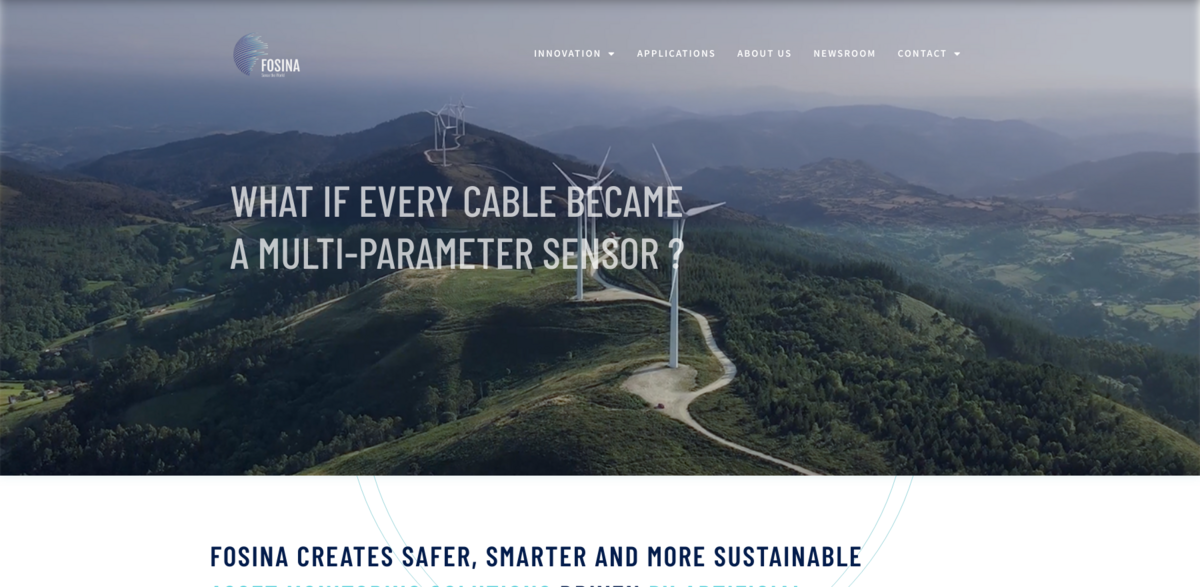What is the Project?
FOSINA introduces an innovative concept where every cable becomes a multi-parameter distributed real-time fiber optic sensor… The solution creates safer, smarter, and more sustainable asset monitoring using artificial intelligence designed to safeguard infrastructure against any failure and unscheduled downtime. Born to be simple, modular, and scalable, the project uses a passive sensor that requires no power along the entire asset. This keen approach leverages the standard telecommunication fiber as a sensor, turning it into thousands of sensing points with the potential to localize with meter size accuracy. The technology is rooted in over 100 staff years of fiber optic sensing expertise and a 30-year heritage from Sensa, all combined with the dynamic spirit of a fast-growing startup.
Main Benefits
Key figures and facts that underline the benefits include:
- Passive sensor: no power required along the entire asset.
- Multi-parameter monitoring: strain, temperature, acoustic, and thermal gradient measured with a single system.
- High resolution: thousands of sensing points with a meter size localization capability.
- Sustainability: maintenance-free fiber optic that offers long MTBF and low-power interrogator.
- Real-time performance: 24/7 distributed monitoring ensures early detection through a high-performance, in-house designed optoelectronics architecture.
Advanced Sensor Technology
This project utilizes existing fiber optic cables as a dual-purpose element – serving as both the sensing component and communication medium. The system not only transforms fiber into a coat of thousands of mini microphones, temperature sensors, or strain gauges, but it also guarantees complete immunity to electromagnetic interference. Such a design ensures reliable operation in harsh environments, including extreme temperatures, corrosive or explosive conditions. With an integrated capability to monitor multiple features ranging from strain to ambient temperature, the solution becomes a real game-changer by offering a high-resolution monitoring network along assets that stretch over long distances.
Innovative Applications Across Industries
The distributed fiber optic sensor finds a wide range of applications. For instance, in renewable energy, the system monitors and pinpoints production variations in windfarms, geothermal, and solar plants in real time. The railway network benefits too, as interference detection and a train tracking system work seamlessly together. In the structural realm, early detection of geohazards or risks affecting vital infrastructures—bridges, landslides, tunnels, and dams—ensures safety and longevity. Applications extend further to include leak detection, pig tracking, and perimeter intrusion monitoring, making it a versatile asset for numerous industries. Additionally, with fiber optic monitoring of maritime and terrestrial activities, the system accurately tracks tidal motion, earthquakes, tsunamis, as well as movements of mammals, vessels, or vehicles.
Cutting-Edge Platform and Custom Features
At the heart of the innovation lies the DxS platform – a modular distributed fiber optic sensing technology that dynamically combines Distributed Acoustic Sensing (DAS), Distributed Strain Sensing (DSS), Distributed Temperature Sensing (DTS), and Distributed Thermal Gradient Sensing (DTGS). This flexible interrogator automatically software-selects between various modes to acquire multiple parameters from just one unit. Alongside this, the platform is equipped with an allocated GPGPU, enabling clients or partners to run custom algorithms with ease. Not stopping there, FOSINA also brings forward the FOWIM technology – a state-of-the-art Weight-In-Motion system that uses only optical fiber for sensing. This passive transducer collects and processes axle weight data from overloaded trucks in real time, ensuring safe traffic flow. Plus, the system is designed for future upgrades, for instance, incorporating tire pressure sensing without replacing the existing sensor.
Seamless Integration and User-Centric Design
A significant appeal of the project is its integrated and customizable web-based user interface. Anyone across the world can remotely access the DxS system through any web browser using a secured, authenticated connection. This interface supports system setup, diagnostics, data visualization, processing, and even alarm notifications. Historical report generation is also available to better comprehend high-risk locations with comprehensive statistics. Every aspect of the system is fortified with TLS security protocols, ensuring that all communication over public networks is encrypted, and that client data is safeguarded end-to-end through multi-factor authentication and certificate-managed user identities.
Project Impact on Sustainable Development
- SDG 9: Industry, Innovation, and Infrastructure – Enhancing monitoring and maintenance capabilities for vital infrastructures.
- SDG 11: Sustainable Cities and Communities – Contributing to smart, resilient urban environments.
- SDG 12: Responsible Consumption and Production – Promoting sustainable and energy-efficient technologies.
- SDG 13: Climate Action – Enabling early detection of geohazards and environmental risks with real-time monitoring.
A Future-Ready Vision
This breakthrough in fiber optic sensing is transforming traditional telecommunication cables into a distributed sensor network equivalent to thousands of microphones, temperature gauges, and strain sensors. The natural, almost conversational rhythm of the system’s operation is evident in its real-time data processing and seamless integration into various applications, from renewable energy production and railway safety to road monitoring and offshore operations. With continuous upgrades, maintenance-free components, and the empowerment of edge computing, the project not only demonstrates technological excellence but also sets the stage for safer and more responsive infrastructure management across cities, countries, and continents… It encapsulates a future where every fiber optic line becomes a guardian of our critical assets, constantly watching and ready to alert before issues evolve into hazards.





















